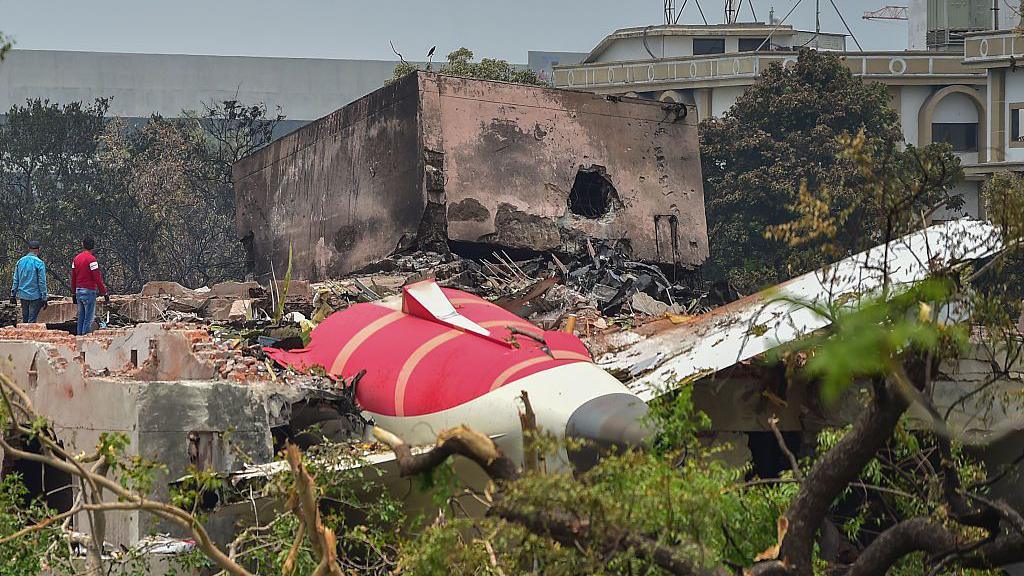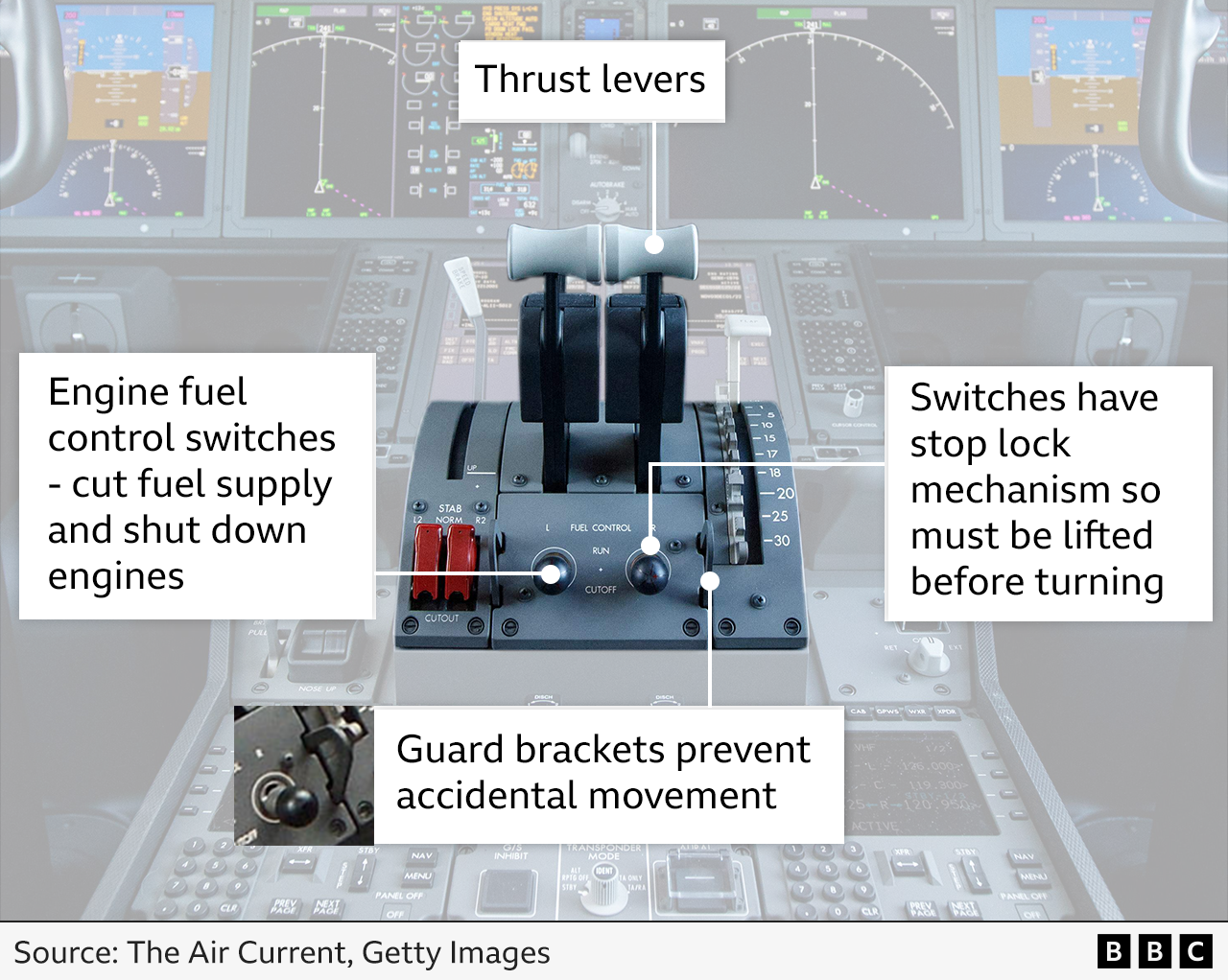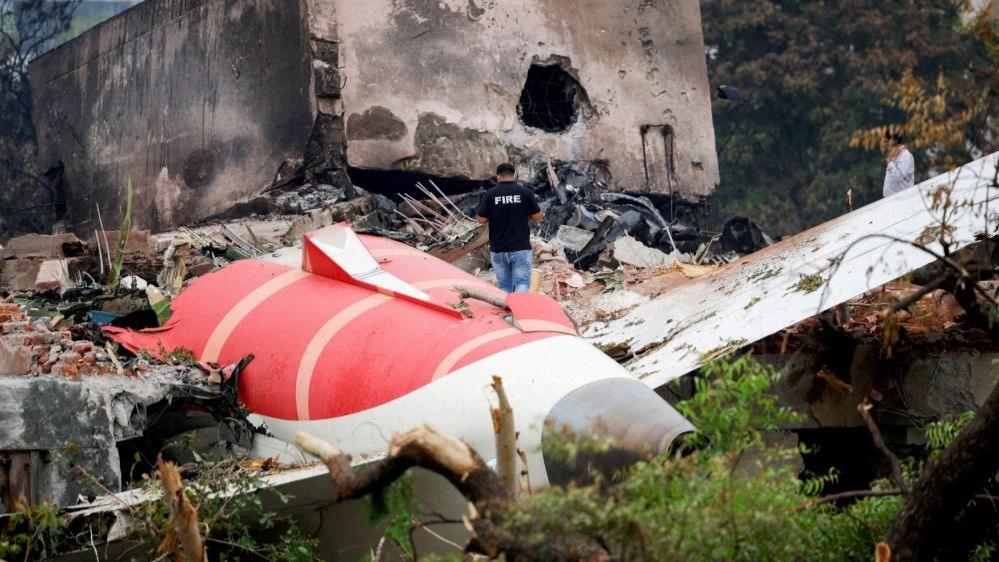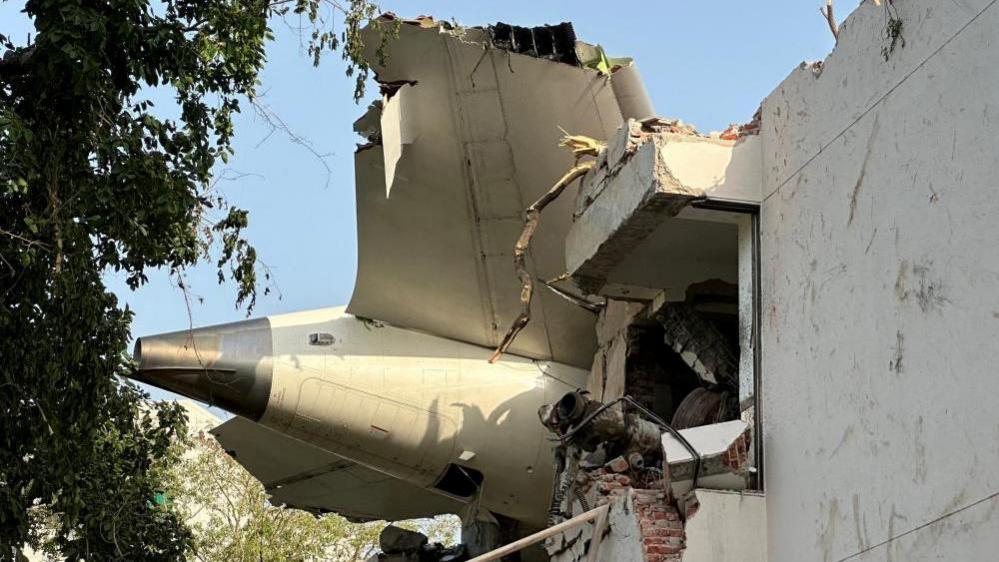The voices in the cockpit fuelling controversy over Air India crash

Air India Flight 171 crashed into a crowded neighbourhood in Ahmedabad
- Published
When the preliminary report into the crash of Air India Flight 171 - which killed 260 people in June - was released, many hoped it would bring some measure of closure.
Instead, the 15-page report, external further stoked speculation. For, despite the measured tone of the report, one detail continues to haunt investigators, aviation analysts and the public alike.
Seconds after take-off, both fuel-control switches on the 12-year-old Boeing 787 abruptly moved to "cut-off", cutting fuel to the engines and causing total power loss - a step normally done only after landing.
The cockpit voice recording captures one pilot asking the other why "did he cut-off", to which the person replies that he didn't. The recording doesn't clarify who said what. At the time of take-off, the co-pilot was flying the aircraft while the captain was monitoring.
The switches were returned to their normal inflight position, triggering automatic engine relight. At the time of the crash, one engine was regaining thrust while the other had relit but had not yet recovered power. The plane was airborne for less than a minute before crashing into a neighbourhood in the western Indian city of Ahmedabad.
Several speculative theories have emerged since the preliminary report - a full report is expected in a year or so.
The Wall Street Journal, external and Reuters, external news agency have reported that "new details in the probe of last month's Air India crash are shifting the focus to the senior pilot in the cockpit".
Italian newspaper Corriere della Sera, external claimed that its sources had told them the first officer repeatedly asked the captain why he "shut off the engines".
Air India plane descending moments before crash
Sumeet Sabharwal, 56, was the captain on the flight, while Clive Kunder, 32, was the co-pilot who was flying the plane. Together, the two pilots had more than 19,000 hours of flight experience - nearly half of it on the Boeing 787. Both had passed all pre-flight health checks before the crash.
Understandably, the wave of speculative leaks has rattled investigators and angered Indian pilots.
Last week, India's Aircraft Accident Investigation Bureau (AAIB), the lead investigator, stated in a release that "certain sections of the international media are repeatedly attempting to draw conclusions through selective and unverified reporting, external". It described these "actions [as] irresponsible, especially while the investigation remains ongoing".
Jennifer Homendy, chairwoman of the US's National Transportation Safety Board (NTSB), which is assisting the investigation, said on X that the media reports were "premature and speculative", external and that “investigations of this magnitude take time".
Back in India, the Indian Commercial Pilots' Association condemned the rush to blame the crew as "reckless" and "deeply insensitive", urging restraint until the final report is out.
Sam Thomas, head of the Airline Pilots' Association of India (ALPA India), told the BBC that "speculation has triumphed over transparency", emphasising the need to review the aircraft's maintenance history and documentation alongside the cockpit voice recorder data.
At the heart of the controversy is the brief cockpit recording in the report - the full transcript, expected in the final report, should shed clearer light on what truly happened.
Air India Plane Crash
When a London-bound Air India plane crashed in the Indian city of Ahmedabad moments after take off, it killed all but one onboard. We hear from eyewitnesses, experts and relatives of those who died.

A Canada-based air accident investigator, who preferred to remain unnamed, said that the excerpt of the conversation in the report presents several possibilities.
For example, "if pilot 'B' was the one who operated the switches - and did so unwittingly or unconsciously - it's understandable that they would later deny having done it," the investigator said.
"But if pilot 'A' operated the switches deliberately and with intent, he may have posed the question knowing full well that the cockpit voice recorder would be scrutinised, and with the aim of deflecting attention and avoiding identification as the one responsible.
"Even if the AAIB is eventually able to determine who said what, that doesn't decisively answer the question 'Who turned the fuel off?'".
"We may even never know the answer to that question."
Investigators told the BBC that while there appeared to be strong evidence the fuel switches were manually turned off, it's still important to keep "an open mind".
A glitch in the plane's Full Authority Digital Engine Control (FADEC) system - which monitors engine health and performance - could, in theory, trigger an automatic shutdown if it receives false signals from sensors, some pilots suggest.
However, if the pilot's exclamation - 'why did you cut-off [the fuel]?' - came after the switches moved to cut-off (as noted in the preliminary report), it would undermine that theory. The final report will likely include time-stamped dialogue and a detailed analysis of engine data to clarify this.
Speculation has been fuelled less by who said what, and more by what wasn't said.
The preliminary report withheld the full cockpit voice recorder (CVR) transcript, revealing only a single, telling line from the final moments.
This selective disclosure has raised questions: was the investigation team confident about the speakers' identities but chose to withhold the rest out of sensitivity? Or are they still uncertain whose voices they were hearing and needed more time to fully investigate the matter before publishing any conclusions?
Peter Goelz, former NTSB managing director, says the AAIB should release a voice recorder transcript with pilot voices identified.
"If any malfunctions began during take-off, they would be recorded in the Flight Data Recorder (FDR) and would likely have triggered alerts in the flight management system - alerts the crew would almost certainly have noticed and, more importantly, discussed."
Investigators are urging restraint in drawing conclusions.
"We have to be cautious because it's easy to assume that if the switches were turned off, it must mean intentional action - pilot error, suicide, or something else. And that's a dangerous path to go down with the limited information we have," Shawn Pruchnicki, a former airline accident investigator and aviation expert at Ohio State University, told the BBC.
At the same time, alternative theories continue to circulate.
Indian newspapers including the Indian Express flagged a possible electrical fire in the tail, external as a key focus. But the preliminary report makes clear: the engines shut down because both fuel switches were moved to cut-off - a fact backed by recorder data. If a tail fire occurred, it likely happened post-impact, triggered by spilled fuel or damaged batteries, an independent investigator said.
Last week, AAIB chief GVG Yugandhar stressed that the preliminary report aims to "provide information about 'WHAT' happened".
"It's too early for definite conclusions," he said, emphasising the investigation is ongoing and the final report will identify "root causes and recommendations". He also pledged to share updates on "technical or public interest matters" as they arise.
Summing up, Mr Pruchnicki said the probe "boils down to two possibilities - either deliberate action or confusion, or an automation-related issue".
"The report doesn't rush to blame human error or intent; there's no proof it was done intentionally," he added.
In other words, no smoking gun - just an uneasy wait for answers that may never even fully emerge.
- Published14 June


